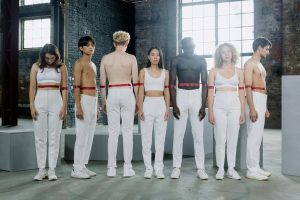The Historical Context Behind Today’s Most Popular Silhouettes
When we think about fashion trends, we often believe they emerge out of nowhere, as if they were created in a vacuum. However, the truth is that fashion is cyclical, and what becomes popular today is often influenced by the trends of the past. From bold colors to unique textures, every aspect of fashion has a rich history, and the same goes for the most popular silhouettes we see in today’s clothing. In this article, we will explore the historical context behind today’s most beloved silhouettes and how they have evolved over the years.
Victorian Era: The Beginnings of Layering Silhouettes
The Victorian era, which lasted from the mid-1830s to the beginning of the 20th century, marked the beginning of layering silhouettes. During this time, women’s fashion was heavily influenced by the hourglass figure, where the waist was cinched and the hips and bust were accentuated. To achieve this look, women wore layers of petticoats and corsets to create a full, voluminous silhouette.
However, as the Victorian era progressed, the silhouette began to shift towards a more natural and slimmer look. Skirts became narrower, and corsets were loosened, giving way to a more relaxed and comfortable silhouette. This transition set the foundation for the silhouettes we see in today’s fashion.
The Roaring Twenties: The Rise of The Flapper Silhouette
The 1920s, also known as the Roaring Twenties, was a transformative period for fashion. The influx of jazz and dancing parties gave women a newfound freedom to express themselves through their clothing. The popular silhouette of the decade was the flapper dress, which was characterized by its straight and loose fit, hitting just above the knee.
The flapper silhouette was a significant shift from the hourglass figure of the Victorian era. Women ditched their bulky petticoats and corsets and embraced a more relaxed, androgynous silhouette. This trend was not only a reflection of the changing times but also a statement of women’s independence and liberation.
The 1940s: The Rise of The Dior Silhouette
The 1940s were a decade of war, and as resources became scarce, fashion became more restrained. However, towards the end of the decade, a designer by the name of Christian Dior revolutionized fashion. Dior’s signature silhouette, known as the New Look, featured a fitted jacket with padded shoulders, a nipped-in waist, and a full skirt.
The Dior silhouette was a stark contrast to the more relaxed and androgynous styles of the 1920s and 1930s. It epitomized femininity, with its fitted waist and exaggerated hips. Dior’s designs were embraced by women as they longed for the return of luxury and indulgence after the war.
The Swinging Sixties: The Birth of The Miniskirt Silhouette
The 1960s was a decade marked by radical changes in fashion, music, and culture. The youth of the time rebelled against the conservative styles of their parents and created a new era of fashion. The most iconic silhouette of the decade was the miniskirt, made popular by designer Mary Quant.
The miniskirt, which was typically cut above the knee, was a symbol of freedom and sexual liberation for women. It symbolized a break from traditional gender roles and was seen as a statement piece of the feminist movement.
The 1980s: The Age of Power Silhouettes
The 1980s was a decade of power dressing, characterized by bold colors, oversized shoulder pads, and structured silhouettes. Women, who were making strides in the workforce, embraced this trend as a way to portray strength and masculinity in the male-dominated corporate world.
The most popular silhouette of the 1980s was the power suit, which featured a tailored blazer with exaggerated shoulder pads, paired with a pencil skirt or dress pants. This silhouette not only gave women a sense of power and authority but also challenged traditional notions of femininity.
Today’s Silhouettes: A Fusion of The Past
As we fast forward to today’s fashion, we can see a fusion of silhouettes from the past. The hourglass figure is making a comeback with the rise of body positivity and the acceptance of different body shapes. At the same time, androgynous styles, much like the flapper silhouette, are seeing a resurgence in popularity.
In conclusion, it’s evident that the silhouettes we see today have been heavily influenced by the trends of the past. From the Victorian era to the present day, we can see how fashion has evolved and how historical events and movements have shaped our clothing choices. So next time you slip on your favorite outfit, take a moment to appreciate the historical context behind its silhouette.










